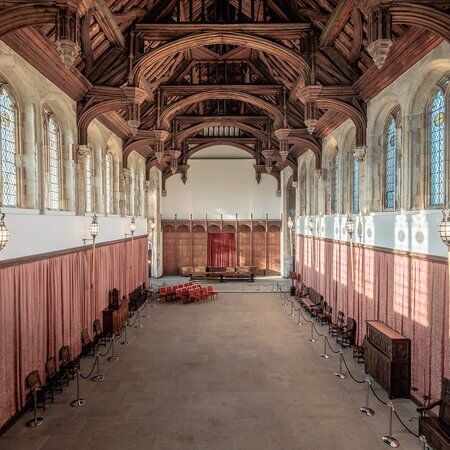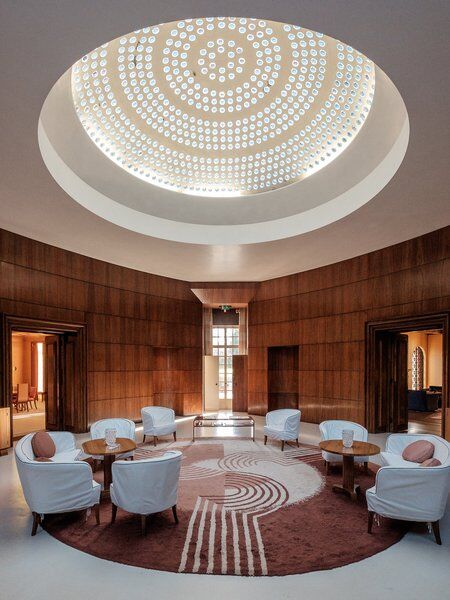
Discover Eltham Palace
Originally a favoured mediaeval palace and later a Tudor royal residence, Eltham Palace in Greenwich is situated within 19 acres of award-winning gardens. According to English Heritage though this striking Art Deco mansion contains more than just lavish interiors and rose gardens. It is also home to spectral inhabitants among which, the ghost of a former staff member continues to provide guided tours. Witnesses have reported encountering the ghost during times when the palace should have been empty, adding an eerie twist to the site's already intriguing history and earning it a place on English Heritage's list of “most haunted places.”

The History of Eltham Palace
Origins of Ownership
Eltham Palace is a mixture of mediaeval and Tudor architecture, which was redeveloped as an eccentric millionaire’s estate in the 1930s. The site's roots can be traced back to the Domesday survey of 1086, where the manor of Eltham belonged to Odo, Bishop of Bayeux, a half-brother of William the Conqueror.
Throughout the centuries, it passed through various hands until it was acquired by Anthony Bek, Bishop of Durham, in 1295. Bek's tenure marked significant enhancements, including the construction of a defensive perimeter wall and moat, and a great hall with intricate features.

As a Royal Residence
Eltham Palace became a royal residence when Bek presented it to the future Edward II in 1305. Subsequent monarchs, including Edward III and Richard II, loved Eltham, which led to its expansion and preservation. Firstly, Richard II, invested in expensive additions such as a walled garden, a dancing chamber, and what is now Cross London's oldest working bridge. Then Henry IV built upon these additions with timber-framed apartments and lodgings for his queen, Joan of Navarre. And Edward IV's reign saw the construction of the great hall.

Henry VIII Era
Henry VIII, who grew up at Eltham, was the first monarch to cease royal investment in the palace. Although he undertook some improvements, including the establishment of a chapel and new royal lodgings, his focus shifted towards other estates like Hampton Court and Greenwich. These estates could be reached by river from Westminster.
Decline of Eltham Palace
Even Elizabeth I, during her reign (1558–1603), only visited Eltham Palace sporadically. By the 17th century, neglect had taken its toll on the palace's condition. King James I, upon encountering the deteriorating state of Eltham, lamented its condition, describing it as "farre in decay."
The last royal visit occurred under Charles I, it was the end of a long period of royal interest in the palace. Parliament's decision to sell it in 1651 to Colonel Nathaniel Rich led to further destruction, with many buildings demolished and the great hall roof stripped of lead.
From here the palace became a farm with the buildings leased out. Although, despite its neglect, efforts to save the Great Hall emerged in the early 19th century. In 1828, repairs began, although the hall continued to be used as a barn.

Reviving Eltham Palace
The 19th century saw some attempts to restore the mansion. In 1859, the construction of Eltham Court nearby brought new life to the area, accompanied by the establishment of gardens and glasshouses. The Great Hall was repurposed as an indoor tennis court and occasionally used for social gatherings.
However, it wasn't until the late 19th and early 20th centuries that restoration efforts were taken more seriously. Between 1911 and 1914, the Office of Works conducted a thorough restoration of the roof and outer walls, bringing Eltham Palace back from ruin.

The Courtaulds at Eltham Palace
In 1933, the wealthy couple Stephen and Virginia Courtauld were looking for a country home near London and felt Eltham Palace fit the bill perfectly. Acquiring a 99-year lease from the Crown, they embarked on transforming the estate into a modern home while preserving its ancient features, with the assistance of architects Seely & Paget.
At first the project faced opposition due to its historical significance as a royal residence, etc. but with the expertise of Sir Charles Peers, the former Chief Inspector of Ancient Monuments, the project commenced.
Internally, the house reflected the Courtaulds' eclectic tastes. Collaborating with designers like Peter Malacrida and Rolf Engströmer, they cultivated a space that combined the historical elements with modern flair. State-of-the-art amenities included electric fires and synchronous clocks synchronised with the mains supply, Siemens' private internal telephone exchange, and a centralised vacuum cleaner.
Outside, the Courtaulds created beautiful gardens, reminiscent of Edwardian and Arts and Crafts styles. Eltham became a beautiful place to showcase their extensive art collection and entertain guests.

Post-Courtauld Era
During World War II, Eltham Palace was quite literally a sanctuary for the Courtaulds, who sheltered from the conflict in their basement bomb shelter. Despite sustaining damages from enemy bombings, the estate endured. However, by May 1944, the couple relinquished their lease, citing the escalating warfare as a primary reason.
Rab Butler, a friend of the Courtaulds, helped transfer the property to the Army Educational Corps. Subsequently rebranded as the Royal Army Educational Corps, the institution used Eltham’s grounds to educate and train military personnel. English Heritage assumed management of Eltham Palace in 1984 and began to restore the palace's interiors and gardens. In 1992, the Corps evolved into the Adjutant General's Corps and bid farewell to Eltham.

Inside Eltham Palace
Ground Floor Interiors
The Eltham Palace interiors exhibit a blend of original and replica furniture and artworks, in a range of styles. From historical drawing rooms, to a Modernism dining area. The walls are fixed with native and exotic woods, pale paint hues contrast with Edwardian vibrancy, and simple minimalist furniture is spread throughout the ground floor.
Great Hall
The mediaeval great hall, originally built for Edward IV in the 1470s, was improved under the Courtaulds' residency. A minstrels' gallery was added and stained glass windows by George Kruger Gray were put in. These colourful panels show the badges of Edward IV and other historical figures associated with the palace.
First Floor
On the first floor, visitors can glimpse how the other half live – the other half being the Courtaulds' – as the bedrooms, reflecting the "Cunard style", are filled with period furnishings and costumes. Virginia Courtauld's Art Deco bathroom stands out as being truly extravagant, featuring gold mosaic and onyx accents. Additionally, visitors can explore rooms previously inaccessible, such as Virginia's walk-in wardrobe and the map room revealing the family's extensive travels.

House Exterior
The exterior of the Courtaulds' residence is just as grand as its interior, with a red brick design and Clipsham stone dressings that are similar to Hampton Court Palace. The butterfly plan features two wings, of which one is intricately linked to the great hall. The entrance colonnade, between the wings, adds a touch of elegance to the overall design.
Gardens
Surrounding the palace, the gardens cared for by English Heritage, are filled with ornamental plantations, shrubberies, and garden "rooms," including a Rock Garden and Rose Garden, that are both examples of formal and informal 1930s gardens.

Explore London with CityDays
The best way to discover more hidden gems around London is to take your time and, ideally, have a pre-planned route that takes you past all the noteworthy nooks and hidden gems.
We can help you there!
The City combines the fun of an outdoor treasure hunt with the historic facts and whimsical trivia of a walking tour.
Answer riddles, solve puzzles and learn more about London’s 2000-year-old history in a new and interactive way - plus you get 20% off food and drink at a historic pub chosen by us!
Take the stress out of planning your visit to London and book your adventure today!
Not visiting London this time? Don’t worry, you’ll find us all over the world.


















